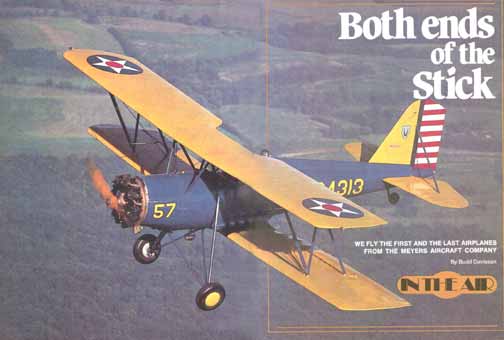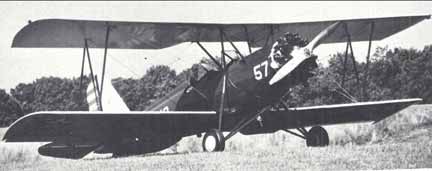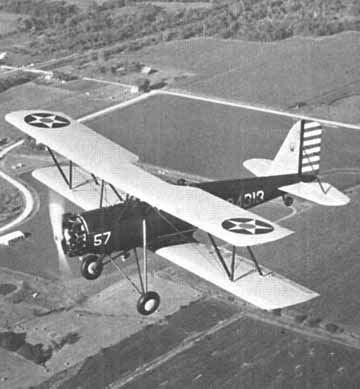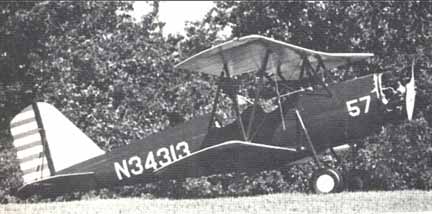

OTW
We fly the first airplane from the Meyers Aircraft Company
Air Progress Vintage Annual - 1989
By Budd Davisson
Considering the fact that the Meyers Aircraft Company was in existence for close
to twenty years, it's interesting that they built only three different models
of airplanes. A lot more than interesting—bordering on fantastic—is
the disparity that exists between these airplanes.
The difference between the first and the last Meyers is about the same as that
which separates the J-3 Cub from the Space Shuttle. However, all three Meyers
models: the OTW, the little 145 and the 200, are all tied together by two very
basic traits—their structure is extremely conservative to the point of
being over-strength and they were designed and built with super attention
to detail in every area.
 |
|
| The Myers OTW was a little gaunt, almost spindly from any angle. But she did what she was supposed to do: turn a groundling into an aviator in record time. |
In the beginning, there was the OTW. Long and angular, it was almost spindly
in appearance. As a trainer in the Civilian Pilot Training Program during World
War Two, it earned itself a reputation for reliability and safety that was second
to none— reportedly a cadet was never killed while learning to fly in
the old OTW.
And then there was the dainty, unabashedly beautiful 145 of the early 1950s.
A radical departure from the OTW, it was certainly one of the prettiest two-place,
retractable gear airplanes ever built. Although only a handful came out of the
factory, those few that survived are considered to be a prize well worth searching
for.
And then there was the mighty 200: Designed from the beginning to be a Bonanza killer, it was exactly that. Although the sales literature shows them to be only a mile or two apart, horsepower to horsepower, the 200 had an obvious edge. Unfortunately, it died an early death because it was extremely complex to build and Meyers just didn't have the marketing or distribution system required to play the Wichita sales game.
How do you describe a Meyers OTW? Simply saying it's a biplane doesn't cut it.
You could say the OTW has "distinctive" styling. Lots of other adjectives
might apply as well, words such as "lanky, gaunt, angular" all seem
to work in one form or another. But, more than any other biplane of its period,
the OTW somehow just looks "different."
Certainly one of the primary reasons the OTW stands out from the biplane crowd,
is that there are no curves. Being of aluminum construction, with fabric covered
wings, you get the impression the only tools the Meyers factory owned were a
sheet metal break and a rivet gun. But then too, when you are building a trainer
to teach wartime pilots how to fly, you don't need "fancy." What you
need is a machine that gets up and down, flies like an airplane is supposed
to and is hard to hurt but easy to fix. That's the Meyers OTW. Supposedly, OTW
stands for Out To Win. It was. And we did.
Yes, walking up to the airplane there is no doubt that it is not your average
WWII biplane. However, unless you are briefed ahead of time it would be easy
to miss the fact that the fuselage is aluminum and is covered with lines of
rivets instead of pinked tape. Also, those long, high-dihedral wings with their
blunt tips have what appears to be an exaggerated amount of gap between them.
This may only be the visual result of the skinny fuselage suspended between
the huge wings.
At first glance, every Meyers OTW appears to have the same five cylinder Kinner
hung out front. But, it's important to know that not all Kinners are created
equal and the OTW had engines as small as 125 hp and as large as 160 hp. The
latter is identical to that used on the Ryan PT-22, sometimes referred to as
five cylinders and a crankshaft working in reasonable proximity to one another.
An airplane this big mated with the little 125 hp Kinner must have been a less
than exciting performer, so virtually every one you see today is using a surplus
R-55 or R-56 Kinner out of a Ryan.
The actual dimensions of the airplane aren't all that much different than those
of a Stearman but it appears much smaller because of its dainty proportions.
Your first hint that this airplane is as big as a Stearman is when you climb
up on the rear of the lower wing. Granted, you may not split the seam in the
rear of your Levi's like you do on a Stearman, but it's still a sizeable step
up off the ground.
 |
|
| The Myers OTW was unique for a lot of reasons, one of them being that it was one of the few all-aluminum biplanes ever built. |
As you step over the fuselage sides into the cockpit, you notice an immediate difference between the OTW and the Stearman. Where the Stearman swallows pilots and students whole, losing them in its cavernous cockpits with only their heads poking out prairie dog fashion, the OTW wraps around the humanoids much tighter. This is compensated for by cockpit cutouts that are quite large and come down relatively low on your shoulders, while the windshield towers over you. When you settle your feet onto the rudder pedals and wrap your hand around the stick and throttle there's no doubt that this is a big airplane because none of the controls would be considered to be anything less than healthy.
The first time I flew an OTW I found the takeoff to be interesting because I
could sit back and watch it happen while giving only a few minor suggestions
to the machine in my role as tour director. With only 160 rather anemic horses
on tap, it lopes along for a while until you get the tail in the air. Then it
continues ahead at the same relaxed pace until the wings balloon with lift and
the OTW leaves the runway in a close to level attitude. If the plane has any
tendency to swerve on takeoff I never saw it and, if it did, that big rudder
on a long moment arm certainly is powerful enough to keep the tail where it's
supposed to be. I never had the chance to fly a 125 hp OTW, but it must be a
real toad in the takeoff department. One hundred and sixty hp makes the OTW
takeoff like a well-mannered, elderly gentleman and fewer horses would make
it behave like a wheezing, old glue factory pony.
Grumble, grumble . . . we're climbing. Sort of. It's time to turn left, so a
little left rudder and aileron. I said left rudder. More rudder. That's it!
True to archaic form and period, turns without rudder make the airplane go one
way and the nose another. Eventually everything winds up in the same place
but to make even the simplest maneuver smooth, the foot-bone-must-be-connected-to-the-hand-bone.
It is, after all, a trainer remember and it's supposed to be flown by the student,
not the other way around.
At altitude, I pushed the nose over into level flight and ... grumble, grumble
. . . the airspeed worked its way around the dial. Slowly. One hundred miles
per hour might as well be Mach 1, as far as the OTW is concerned.
 |
|
| The long, lean lines of the OTW include low cut cockpit combings which left the pilots sticking out into the wind, but the big windshields keep them comfortable. |
The reason the windshields are so tall becomes apparent as the speed builds. In the back seat, where you usually solo, just poking your head slightly above the windshield shows you that the downwash off the wing would just love to get at you, but the windshield does the protecting. The front pit, naturally, is nearly dead calm.
Describing the control response of the OTW again calls for a handful of adjectives.
How about "leisurely?" Or, maybe "sedate." What you have
here is an airplane with huge wings that will never, ever, no matter how hard
it tries, be a Pitts Special. As a trainer, the controls are well harmonized
and absolutely demand the student coordinate, if he wants to get where he wants
to go without slithering through the sky in all manner of awkward moves.
The same adjectives that apply to roll rate and control response could
be used on aerobatics. Want to roll? You'd better put your nose down and get
another 15 mph, which isn't easy. Then be sure to get the nose well above the
horizon before you start a big, lazy barrel roll or positive G aileron roll.
Don't worry about trying to hold a point because putting the nose on a given
point will leave you hanging from your seat belt for an inordinate amount of
time while the OTW tries to decide to go all the way around.
Loops? The same thing! Put the nose down plenty and let the airspeed build until
you can afford to lose a bunch. You have to have that margin because, the second
you start the nose uphill, the speed starts downhill. Fast! The best you
can do from a reasonable entry speed is a big, smooth, but thoroughly egg-shaped
loop.
As would be expected, the stall characteristics are certainly not going to give
the student any idea of what to expect from a Mustang. It does have a stall
and, by aggravating it a bit, you can get a gentle break. But "gentle"
is the key word. As it sluffs off to one side, just release back pressure and
wake the Kinner up and everything is cool again.
Rumble, rumble, rumble . . . we're looking for the airport. Oh, there it is
over there. We don't even worry about slowing down as we enter the pattern because
the OTW is always slower than anything else likely to be there, ultralights
notwithstanding. Speed reduction means simply bringing the power back and holding
the nose level, period. Opposite the end of the runway on downwind, the power
is cut and the nose is dropped to compensate. Airspeed? Who knows? Just
keep the nose down and the power back and you'll be somewhere in the ball
park. Don't forget to keep the base leg in tight so you don't have to depend
on that Kinner should it decide to ingest a load of ice.
Turning final, you’ll notice you never lose the runway behind the nose.
You are sitting so high in the machine and the nose is so far down that you
have a front row seat for everything that happens. The first time I landed the
airplane, I motored down and flared at what I thought would be an appropriate
altitude. As I started the hold-it-off-until-it-stalls game, I felt a slight
bump and realized, "Hey, we're on the ground!" Long before I was ready
for them, the landing gear had gently rolled onto the pavement in the prettiest
wheel landing you've ever seen. I just pinned the gear down with a little forward
pressure and said nothing in response to the owner's comments about my prowess.
He doesn't know that it was an accident. Subsequent landings were all three-pointers
made from a slightly higher flare altitude. The super long-stroke landing
gear and big wheels made what would normally have been bouncing arrivals into
nothing more than ho-hum affairs as they soaked up any rebound nicely.
I would be lying if I said I knew every nook and cranny of the OTW's soul. I've
spent some enjoyable hours bouncing around several grass strips and chasing
sunsets across the horizon in the OTW. The sunset always won, but I still came
away a winner. At least I've had a chance to make its acquaintance.
One of the less common WWII airplanes, it always seems willing to share what
it knows with its driver.
As the patriarch of the Meyers family, the plane lets you know where the line
started. The OTW has to show you the roots of the family tree. And, although
the family tree is a little on the short side having only three branches, it
still can boast that, while it may be short of quantity, there are few with
more quality.
MEYERS OTW SPECIFICATIONS
Engine ........................160 hp
Kinner R-56 Max Speed .................... 120 mph
Cruise Speed .................. 105 mph
Climb ........................ 1,200 fpm
Ceiling ........................ 17,500 ft
Range ........................400 miles
Empty Weight ..................1,340 Ibs
Gross Weight ..................1,910 Ibs
WingSpan .................... 30ft
Length ........................ 22 ft,8in
Height ........................ 8 ft,6in
Wing Area .....................262 sq ft